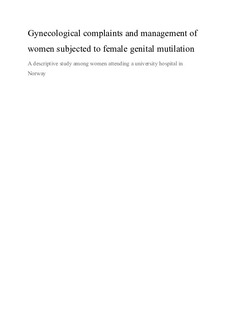Gynecological complaints and management of women subjected to female genital mutilation - A descriptive study among women attending a university hospital in Norway
Master thesis
Permanent lenke
http://hdl.handle.net/11250/2458015Utgivelsesdato
2017Metadata
Vis full innførselSamlinger
Sammendrag
Abstract Background Female genital mutilation (FGM) is a harmful traditional practice comprising procedures involving partial or total removal of external female genitalia and/or narrowing of the vaginal orifice for non-medical reasons. Due to migration pattern, it is estimated to be approximately 17,300 girls and women subjected to FGM currently living in Norway. A number of publications over the last decades have reported long-term health complications after FGM. However, there is a lack of publications on characteristics and quantitative findings in a Norwegian health care setting, especially concerning gynecological impacts of FGM.
The aim of this study was to explore the gynecological complaints, treatment interventions and management of women subjected to FGM in a Norwegian health care setting.
Methods We conducted a retrospective, descriptive study based on medical records of women with FGM who had been in contact with St. Olavs Hospital, University Hospital of Trondheim, Norway, throughout 2004 - 2016. A total of 158 cases were included.
Results Among the 158 women in this study (mean age 26.9, SD = 6.5 years), the majority were from Somalia (n = 96, 60.8%) and Eritrea (n = 32, 20.3%). 125 women (79.1%) presented with FGM type III, 16 (10.1%) with type II and 10 (6.3%) with type I. 69 (55%) women discussed a possible deinfibulation with a gynecologist. At first gynecological examination, FGM was not described for 20% of the women. Gynecological complaints were described among 119 (75%) women. The most common gynecological complaints were abdominal and pelvic pain (n = 70, 44%), dyspareunia, apareunia (n = 60, 38%) and dysmenorrhea (n = 49, 31%). 86 women (69%) with FGM type III underwent deinfibulation. 20 of the procedures (23%) were performed during vaginal delivery.
Conclusion Our study describes health complaints, treatment interventions and management of women who have been subjected to FGM. We have shown that a substantial part of these women have a high prevalence of gynecological pain conditions, and that this applies to all types of FGM. Healthcare-workers should be aware of these women’s need for medical care, 2 and to a greater extent document their complaints and findings in their contact with women subjected to FGM.
